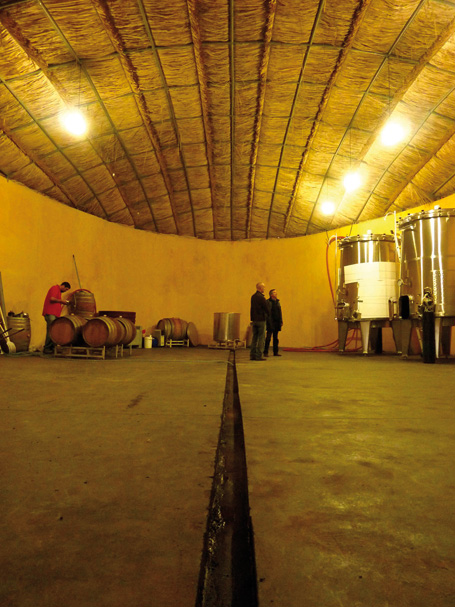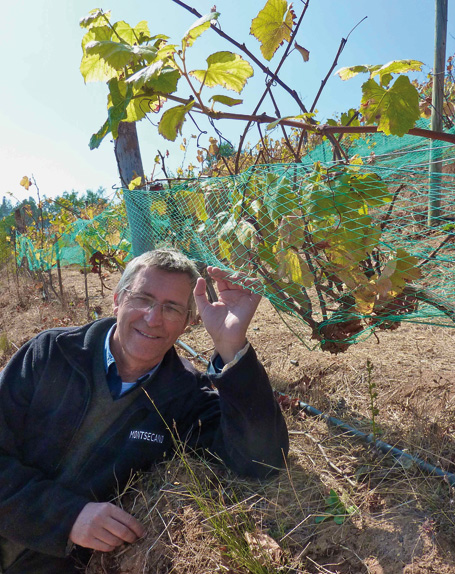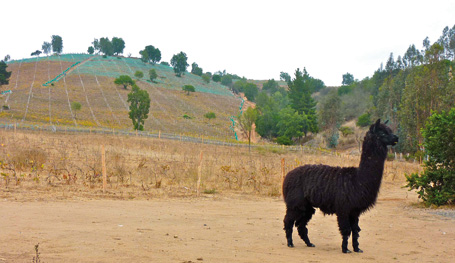World Chile

An art-house wine from the other side of the world
The Montsecano is considered to be one of Chile's best Pinot Noir. Only one varietal for a small vineyard, managed in biodynamics, created by 4 Chilean and Frenchmen among them the Alsacian André Ostertag.
Towards the end of a small dirt track lost in Casablanca's valley—one of the main vitivinicultural valleys of Chile located 75km west from Santiago—the granitic hills of Secano Costero appear. It is on their sides, overhanging a rural horizon bristling with cactuses, that four men with a passion for wine planted 5.5 hectares of Pinot Noir which produce the wine Montsecano.
“It is born from the meeting of three friends”, its oenologist André Ostertag, famous Alsacian wine maker, states.
“I believe that a wine always stems from a friendship first of all.”It is the current manager of the company, Julio Donoso, Chilean photographer who lived into exile in France, who, seven years ago, proposes the crazy idea of a vineyard at the other side of the world to André, seduced by the project and the land. Another Chilean photographer living in France, Álvaro Yáñez, and the entrepreneur Javier de la Fuente become their financial partners.

Cave de Montsecano créée par Marc Nomblot
“It is a small-scale project, unusual in Chile”, Julio Donoso specifies with shining eyes,
“as it respects the contour lines and as its density is twice what is usually practised here. We have between 7,800 and 8,300 stocks per hectare”. Thus a more Burgundy-like than Chilean vineyard for a rare wine. Its production does not exceed 5,000 bottles a year, mainly exported to Brazil and Finland. Its alcohol content is also far under that of the Chilean wines: 12.7%.
Vigne Montsecano
Fundo El Refugio
Estero Las Dichas
Casablanca - CHILI
Tél.: +56 2 819490995
www.montsecano.com
Julio Donoso
Located at only 10km from the Pacific Ocean, its terroir benefits from mist in the morning, sun in the afternoon, a very large temperature range and wind.
“This avoids many diseases like oïdium” Julio states. Even more valuable climatic characteristics since neither pesticides nor weedkillers are used here. Everything is managed in biodynamics.
“We follow the calendar of the school of Rudolf Steiner, elaborated by Colombian René Piamonte”, Julio explains,
“and the tide calendar for the bottling”. The estate also produces its own compost in which are integrated, at homeopathic doses, biodynamic preparations to fortify the soils.
In the same philosophy, Montsecano employs a bit particular workers. There is Marguerite, the mare in charge of the ploughing of the vineyard, in order to avoid carbon emissions from tractors. The alpacas which "clean up” the vineyard in autumn, winter and early spring, before buds appear.
“And the ducks which, for their part, eat the parasites” Julio ads. As for vinification, it is partially undergone in concrete egg-shaped tanks, created by Marc Nomblot. He also is the one who imagined the cellar dug into the hillside, giving it the form of an egg,
of course.
Claire Martin

L'alpaca fait partie des ouvriers dans ce type de vignoble.



